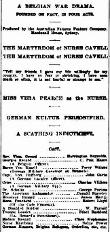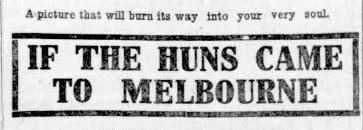AustLit
Latest Issues
AbstractHistoryArchive Description
'This biographical representation is meant as a tribute to the memory of that glorious martyr, Nurse Cavell, who so willingly gave her life for her country and humanity's sake. It deals with historical facts, and shows the cruelty and inhumanity of the German in a most striking and vivid manner. It should bring excellent results as a recruiting film.'
Source: 'New Australian Photoplay', Sunday Times, 23 January 1916, p.16.
Notes
-
The Woman Pioneers in Film Project contains some advertising material and still for this film, taken from the National Film and Sound Archive, on its Agnes Gavin page. (Sighted: 8/7/2014)
Publication Details of Only Known VersionEarliest 2 Known Versions of
Works about this Work
-
From Martyr to Robo-Nurse : The Portrayal of Australian Nurses on Screen
2014
single work
criticism
— Appears in: Studies in Australasian Cinema , vol. 8 no. 2/3 2014; (p. 110-122) 'Nurses have traditionally been seen as among the most trusted of workers, with cultural connections with caring and femininity long been associated with their profession. While the portrayal of nurses in overseas screenworks has had some attention, Australian productions have not. This study identifies four categories of screenworks: popular entertainment, training and recruitment films, wartime nursing, and nurses as workers and unionists. Although more recent mainstream media portrayals of nurses increasingly depict strong, assertive professionals, little research has been conducted into the fourth category, a significant number of which are made by nurses. When nurses take on the film-making task, different outcomes are produced. New types of film about nurses and by nurses offer an evolving representation of the profession and are helping to change the identity of nurses.' (Publication abstract) -
Convention and Contradiction : Representations of Women in Australian War Films, 1914–1918
1999
single work
criticism
— Appears in: Australian Historical Studies , October vol. 30 no. 113 1999; (p. 215-230)'This paper examines the representation of women in Australian cinematic war dramas made between 1914 and 1918, showing how the representations were shaped by political, industrial and ideological influences and identifying the range of representations present in the films. It observes that while there was considerable overlap with other media in the representation of women, there were images ignored by films, while others were unique to the cinema.'
Source: Abstract.
-
From Martyr to Robo-Nurse : The Portrayal of Australian Nurses on Screen
2014
single work
criticism
— Appears in: Studies in Australasian Cinema , vol. 8 no. 2/3 2014; (p. 110-122) 'Nurses have traditionally been seen as among the most trusted of workers, with cultural connections with caring and femininity long been associated with their profession. While the portrayal of nurses in overseas screenworks has had some attention, Australian productions have not. This study identifies four categories of screenworks: popular entertainment, training and recruitment films, wartime nursing, and nurses as workers and unionists. Although more recent mainstream media portrayals of nurses increasingly depict strong, assertive professionals, little research has been conducted into the fourth category, a significant number of which are made by nurses. When nurses take on the film-making task, different outcomes are produced. New types of film about nurses and by nurses offer an evolving representation of the profession and are helping to change the identity of nurses.' (Publication abstract) -
Convention and Contradiction : Representations of Women in Australian War Films, 1914–1918
1999
single work
criticism
— Appears in: Australian Historical Studies , October vol. 30 no. 113 1999; (p. 215-230)'This paper examines the representation of women in Australian cinematic war dramas made between 1914 and 1918, showing how the representations were shaped by political, industrial and ideological influences and identifying the range of representations present in the films. It observes that while there was considerable overlap with other media in the representation of women, there were images ignored by films, while others were unique to the cinema.'
Source: Abstract.
- Belgium, Western Europe, Europe,
- 1915





